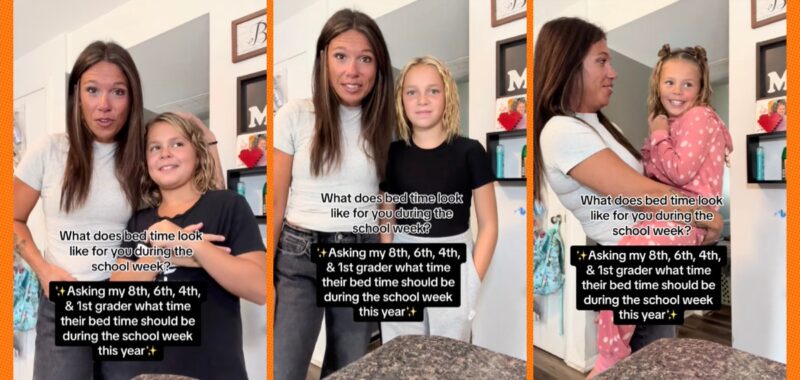For years, my children’s sleepy time routine stayed the same: when 8 p.m. rolled around, everyone knew it was time to head upstairs, brush their teeth, read a book, and go to bed. As they got older, it was hard to know whether I should heed their pleas for a later bedtime.
What should an eighth grader’s bedtime be? TikTok user @lexismoun had a novel solution: ask her four children what they thought their bedtime should be.
One by one, in descending order of age, she asked her kids what time they considered reasonable to hit the hay on a school night. Her eighth grader (soon to be 14 years old) suggested 10 p.m. to 10:30 p.m. Her sixth grader (12), suggested the same, which mom was willing to think about but prompted protest from her older brother.
“My bedtime in 6th grade was 8,” he deadpanned.
“That’s what you get for being the oldest,” his mom laughed and, honestly, as an oldest child and mother of two: facts.
The OP’s fourth grader thought 9 p.m. was reasonable and mom agreed, while the baby of the family — a 6-year-old first grader — adorably demonstrated her inability to effectively haggle: when her request of 10:30 p.m. was denied she countered “12!” (Mom thought 8 or 8:30 was more reasonable.)
And honestly? These kiddos are pretty spot-on in their assessment!
According to guidelines established by the American Academy of Sleep Medicine (AASM) and endorsed by the American Academy of Pediatrics (AAP), children between kindergarten and about sixth grade (6 to 12 years old) require somewhere between nine and 12 hours of sleep per night.
Kids in middle and high school (13 to 18-year-olds) require slightly less: eight to 10 hours should suffice. The exact number will depend on circumstance as well as individual needs: some folks need closer to 12, others can skate by on fewer than eight and feel fine.
The AAP cautions that routinely insufficient sleep has been linked to inattention and behavioral and learning problems as well as the risk of accidents and injuries. Unfortunately, for our children’s natural circadian rhythms, the start of school establishes a set time they have to wake up. Experts, including those at the AAP, believe school start times are often too early and interrupt a healthy sleep cycle, particularly for tweens and teens.
In fact, in 2014, the AAP released a policy calling for middle and high schools to start no earlier than 8:30 a.m. Unfortunately, many schools have not paid heed to the recommendation.
Nevertheless, there are things parents can do to help their kids get sufficient sleep. Establishing a regular daily routine, for example, with the same wake times, meal times, and bedtime “ritual” can be helpful. Getting kids physically active during the day (through play, sports, or other activities that provide exertion) can also be helpful, particularly in conjunction with monitoring their screen time usage. (The AAP recommends keeping all screens, including phones and tablets) out of bedrooms. And definitely avoid over-scheduling your school-aged child.
“They cannot play three sports, play in the band, and join the chess club and still get enough sleep to do well in school,” said Dr. Lee J. Brooks, a member of the AASM panel and the AAP Section on Pediatric Pulmonology and Sleep Medicine Executive Committee in a statement “You might see poor school performance, you might see kids labeled as troublemakers when in reality they just don’t get enough sleep.”
But the AAP’s first recommendation is, perhaps, the hardest for parents to adhere to: make sufficient sleep a family priority. In other words, remember you’re a role model and should set a good example. “Staying up all night with your teen to edit his or her paper or pulling an all-nighter for work yourself isn’t really sending the right message,” the academy states in its guidelines. “Making sleep a priority for yourself shows your children that it’s part of living a healthy lifestyle—like eating right and exercising regularly.”
Call us out why don’t you, AAP? Sheesh…

